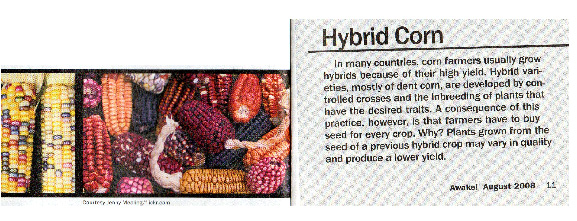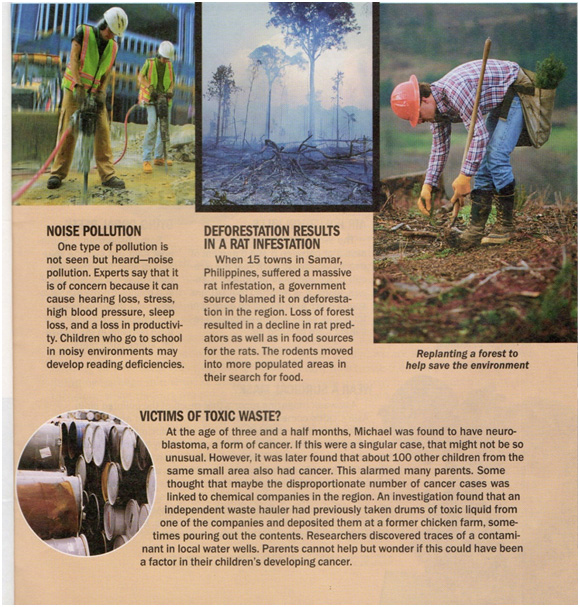The world of nature illustrates a mastery of sciences, an example of this is the special patterns presented in flowers and fruits illustrated below. No. 4 illustrates the mathematical formula present in all natural growth which ultimately reaches the mathematical presentation of infinity. The Lotus flower illustrates the greatest number of petals which mathematically brings its structural growth close to perfection which may be why it is associated with important aspects of both the Hindu and Buddhist teachings in which it represents purity, fertility, good fortune and progress.

Within the natural world children can feel and experience the material elements and physical forces that have been, and are yet to be, used within the construction of our scientific and technological world. Some educators might suggest that from the natural environment children can also discern ‘what makes life possible:-
- Earth’s abundant water.
- The correct amount of heat and light from the sun.
- Our atmosphere with its right mix of gases – life supporting air.
- Fertileland.’(Watchtower,Feb 15th 2007:7)
Some religious and spiritual teachings have also related the qualities of different aspects of natural phenomena as inspiration to spiritual consciousness and personal aspirations. For example:-
Earth – ‘The earth is always tolerant, patient and forgiving.’
Mountains – Mountains give us ‘trees, herbs, and water….We should learn from those mountains how to work for the benefit of others.’ Mountains are very silent and favourable for spiritual development.
Trees – ‘You should be as tolerant as a tree.’
Water – ‘the qualities of water are purity, softness and refreshment.’
The honey bee – takes only a little from each flower, and teaches us not to take more than we need. (Narayana Maharaja,2005)
Similarly the native Indian teachings associate animals with different qualities of relationship with life, e.g:-
The ant represents patience and strategy, and teaches the positive results of team work.
The horse represents stamina, riches and power, and teaches loyalty to those you trust.
The deer represents deliberation, great awareness and speed, and teaches gentleness and peace.
The hawk represents observation and patience and teaches the importance of taking the right action at the right time.
The mole represents sensitivity to touch and vibration and an understanding of mother-earth energy, and teaches self-reliance and cheerfulness. (Palmer,2001:11,198-199,111,193,227.)
When given an opportunity to observe, day after day, parent birds feeding their young, children can perceive the adult birds’ outstanding commitment and stamina within their parenting role.
Thus, the animal kingdom presents simple and clear aspects of relationship with life for a young child to perceive and appreciate. The child’s inner awareness and external freedom to spontaneously associate with wild plants and animal life can support an active interest in gardening and the care of domestic animals. (Montessori,1967:71-74)
Outdoor play may help children develop a deeper and clearer understanding of the relationship between man’s activities and the ecology of the earth. Watts proposes that young children educated within a natural outdoor environment can embrace ‘the unity of nature’ through their sensory–motor experiences, and their thinking evolves a ‘naturalistic shape’ and growing awareness of the ‘various applications of nature’s universal laws…..’ (Cited in International Froebel’s Society conference,2004:34). Many young children whose suburban life style does not include outdoor educational experiences may not understanding natures influence upon their everyday life style. For example, for some young children, milk is a white liquid called cows-milk or sometimes goats-milk, sold in a carton at the supermarket. One can only guess how the young child might comprehend the word cow or goat when s/he has only seen cows in picture books or maybe from a car driving past fields. Indeed anyone’s comprehension of the word cows-milk might be rather obscure without a direct experience of how mammals suckle their young or, better still, calves feed from their mother’s milk and the human process of dairy farming or hand milking.
As adults the young children of today will be facing new and important issues on the further developments in the use of genetic technology within both horticultural and animal farming, animal experimentation and the evolution of human genetic sciences.
‘…more importantly, there is an urgency to provide young children with wild environmental experiences and to let them know how beautiful the natural environment is to protect it for the future and for all the children of the earth.’(Moyles, 2007:183)

Conservation and growing levels of pollution within the inner cities and urban environments are also important issues that young children of today will be faced with as adults.

Within the world of nature God’s presence is tethered to a complexity of environmental issues related to survival.
When man works in harmony with nature, issues of ecology are related to man’s endeavour and God’s mercy, together this brings abundance.
When man works in harmony with nature, issues of survival are related to mans’ ability to work in harmony with the divine life force; this brings sustainability.
Learning to care through the growing and harvesting of vegetables.
Learning to share through the growing and harvesting fruit.
Learning to love through the growing and sharing of flowers.
The research of Cobb in 1977 concluded that ‘inventiveness and imagination’ was rooted in ‘early experiences in nature’. (Cited in Louv,2006:93)This supports the growing development of natural spaces, woodlands and green spaces, as beneficial projects for children and adults to share in city and urban environments. (O’Brian,2005:43)
Steiner described an essential feature of young children is that they give up their ‘whole being to the environment….,’ (Steiner,1982:28)and the essence of gratitude develops out of a ‘bodily-religious relationship’ with movement and the senses. Feelings of thankfulness, gratitude, joy may emerge ‘out of ‘one’s feeling life’ when ‘beholding any of nature’s phenomena…..This gratitude lives in the physical body and it must dwell in it, since otherwise it would not be anchored deeply enough’ (Steiner,1988a:128-129) to develop a natural mood of appreciation. The young child initially learns through his feelings rather than his mind or intellect and this is how he perceives beauty and experiences joy and formulates his expression of intelligence and child-like purity of thought.
Montessori suggested that unnatural possessiveness in children, seen as a desire to seize and often destroy, is resolved when children are supported with natural environments which help them aspire towards the best part of their nature, which ‘tries to understand life, so as to protect and improve it’, and through ‘intelligent insight’ help living things. (Montessori,1988:201) Montessori also suggests ‘It is therefore easy to interest them in taking care of plants and especially animals’ and she describes one morning when she observed the children ‘all seated in a circle on the floor around a magnificent red rose that had opened up during the night. They were silent, peaceful, completely absorbed in contemplation.’ (Montessori,1967:71)
‘For everything going on in nature is permeated by a hidden music, the earthly projection of the “music of the spheres.” Every plant, every animal actually incorporates the tones of the music of the spheres.’ (Steiner,1982:19)
Bibliography
Gardner, H. &Kornhaber, M.A. & Wake, W.K.Intelligence:Multiple Perspectives. London: Harcourt Brace College, 1996.
Roberts, A & Featherstone, S. The Little Book of Treasure Baskets. Husbands Bosworth: Featherstone Ed., 2002.
Mortari, L&Zerbato, R, Eds. Adventures in Nature.Edinburgh:Children in Scotland, 2008.
Taylor, J. My Stroke of Insight.London: Hodder & Stoughton,2009.
Bhaktivedanta Narayana Maharaja ed. Sri GaudiyaGiti-Guccha.Mathura (India) :Gaudiya Vedanta Publications, 2002.
Purnaprajna Das. Shri ChatanyaCharitamrita. Maharashtra (India): BhaktiratnaSadnu Swami, 2002.
Bhaktividanta Swami Prubhupada A.C. KRISNA. New York: Bhaktividanta Book Trust, 2002.
Lindon, J. Understanding World Religions in Early Years Practise London; Hodder & Stoughton:1999
Elass, M.The true Seeker (Booklet). International Bible Society, 1997.
Bruce, T. McNair, L. WynSiencyn, S. I Made a Unicorn! Robertsbridge:Community Playthings, 2008.
Good News Bible2ndEd.Harper Collins, 1994.
Moyles, J. Ed. Early Years Foundations Maidenhead Open University Press, 2007.
BharahMirchandani, Ed. Heart is Thy Name ,Oh Lord –Sri RamanaMaharsh. Tamil Nadu (India): V.S. Ramanan, 2004.
Sims N. Ed.The Brain and Central Nervous System. London; The Readers Digest Association,2000.
Fisher, R. Teaching children to think.Oxford; Blackwell, 1990.
Thornton, L.&Brunton, P. Bringing the Reggio Appproach to your Early Years Practice. Routledge; London, 2007.
Steiner, Rudolf. Child’s Changing Consciousness & Waldorf Education. New York: Anthroposophical Press, 1988a.
Steiner, Rudolph. Balance in teaching. New York : Mercury Press, 1982
Steiner, R. Necessity and Freedom.London; Anthroposophic Press, 1988.
Steiner, R. The foundations of human experience.London; Anthroposophic Press, 1996.
Steiner, R. The roots Of Education.London; Anthroposophic Press, 1997a.
Steiner, R. Truth and knowledge 2nd Ed. London; Rudolph Steiner Publications, 1981.
Mac Naughton, G. Shaping Early Childhood. Maidenhead; Open University press, 2003.
Honore, C. In Praise of SLOW.London; Orion, 2004.
Frost, S. Fitness For Kids. London; Connections, 2003.
Garrick, R Playing Outdoors in the Early Years. London; Continuum,2004
Harrison, S.The Happy Child.Colorado; Sentient, 2002.
Ouvry, M. Exercising muscles and minds.London; National Children’s Bureau, 2003.
Montessori, M. The Absorbent Mind.Oxford; Clio Press, 1988.
Montessori, M. The Discovery of the Child. New York; The Random House, 1967.
Department for Children, Education, Lifelong Learning Skills.Framework for Children’s Learning for3 to 7-year-olds in Wales.Cardiff; Welsh Assembly Government, 2008.
Einarsdottir, J. &Waagner, J. T. Eds. Nordic Childhood and Early Education.Conneticut; Information Age, 2006.
Smidt, S.Early Years Practice (2nd Ed.) London; Routledge/Falmer, 1998.
Goldschmied, E. & Jackson, S.People Under Three 2nd Ed. London; Routledge, 1994/2004.
International Froebel’s Society conference july2004, programme of events and abstracts of presentations and workshops. Froebel college or university of Surrey roehampton.
Ceppi, G. &Zini, M. Eds, Children, Spaces, Relations, Reggio Emilia: Reggio Children, 1998.
Goddard-Blythe, S.The Well Balanced Child.Stroud; Hawthorn Press, 2004.
Walls, V. The Miracle of Colour Healing. London; Thorson,1991/1995
Louv, R. Last Child in the Woods.North Carolina;Algonquin Books, 2006.
Austin, R. Ed. Letting the outside in. Stoke on Trent; Trentham Books, 2007.
Knight, S. Forest of schools and outdoor learning in the Early Years.London; Sage, 2009.
Wellhousen, K. Outdoor Play Every Day. New York; Delmar, 2002.
Hobday, R. The Healing Sun. Finhorn Press; Forres, 1999.
Callaway, G. The Early Years Curriculum a view from outside. Fulton; London, 2005.
Danks, F. & Schofield, J. Natures Playground.London; Francis Lincoln, 2005.
Palmer, J.D. Animal Wisdom. London; Element, 2001
Montessori, M. The secret of Childhood.New York; Ballantine, 1966.
Vander, A., Sherman, J. & Luciano, D. Human Physiology 8th Ed.New York; McGraw-Hill, 2001.
Khalsa, D. S. The Mind Miricle. London; Arrow Books,1997.
Gurian, M. Boys and Girls Learn Differently.USA; Jossey-Bass, 2001.
Lavery, S.The Healing Power of Sleep.London; Gaia Books, 1997.
Doman, G. What to do about your Brain Injured Child. New York;Doubleday and Company,1960.
Blyth, P. &McGlown,D.J. Chester; Insight Publications, 1979.
Bradburn, E. Margaret McMillan. Redhill; Denholm House, 1976.
Frost, S. Fitness for Kids.London; Connections, 2003.
Rowland, T.W. Exercise and Children’s Health.USA.;Human Kinetics, 1990.
Bhaktivedanta Narayana at Badger California : June 18th, 2005. Giving a discourse on the book Sri BhagavataArkaMaricimala by SrilaBhaktivinodaThakura.
O’Brian, L. Trees and Woodlands: Nature’s Health Service. Farnham; Forestry Commission, 2005.
Standing, E.M. Maria Montessori – Her Life and Work.New York; Mentor-Omega Books, 1962.
Meadows, S. The Child as Thinker 2nd Ed. London; Routledge, 2006.
Scotson, L. Doran, Child of Courage. London; Pan Books, 1985.
Steiner,R. The Essentials of Education.USA; Anthroposophic Press, 1997a.
O’Brian, L & Murray, R. Forest School and its impacts on young children: Case studies in Britain. Elsevier/Urban Forest &Urban Greening.No. 6, 2007.www.sciencedirect.com
MacMillan, L. Creating Outdoor Classrooms. USA; University of Texas Press, 2008.
Mac Naughton, G. Shaping Early Childhood. Maidenhead; Open University Press, 2003.
